

Weather is cyclical: flood -- drought; hot --cold; windy --calm; hazy -- clear; high pressure --low pressure.

|
These polar opposites can all be related to "upness" and "downness" of the atmosphere. But there are apparent contradictions. We feel up when it is cloudless, sunny and warm. Good things are happening. The grapes are ripening in the September sun The weather is good for golf, for football and for other outdoor sports. It is wonderful for gardening and house repairs. Yet, it is the result of atmospheric downess. Up results from down. Last week, it was cold and rainy. The weather was the opposite of all the above. People were grousing about the early wetness. The weather was producing a downer. Yet, atmospheric-wise it was a period of upness. Down came from up. How can that happen? There is a logical answer to this apparent contradiction. This is best seen through a sequence of atmospheric events summarized by the co-called precipitation ladder. The ladder is simply a mental hook for remembering which step follows which.
|

![]() Words on the Weather Articles:
Words on the Weather Articles:
London Fog | Weather's Ups and Downs | Yin/Yang of Weather | Clouds from Prison
Under-the-Weather Man | Weather and Literature | For Spacious Skies | El Niño | Summer Solstice
![]()
![]()
All Rights © Copyright John A. Day, 1998 - 2007
Site Design by DoubleRich Design
Last updated on: